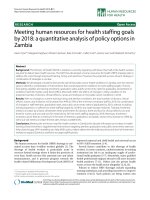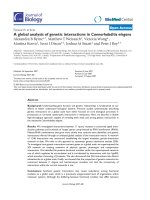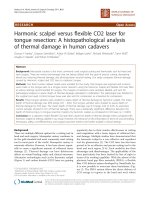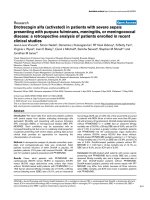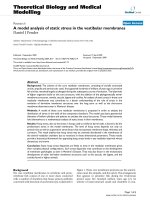A sociolinguistic analysis of the bilingual approach to the teaching of chinese language in singapore
Bạn đang xem bản rút gọn của tài liệu. Xem và tải ngay bản đầy đủ của tài liệu tại đây (7.18 MB, 202 trang )
A SOCIOLINGUISTIC ANALYSIS OF THE
‘BILINGUAL APPROACH TO THE TEACHING OF
CHINESE LANGUAGE’ IN SINGAPORE
TAN GEOK POH ANDREA
(B.A (Hons), NUS)
A THESIS SUBMITTED FOR THE DEGREE OF MASTER OF ARTS
DEPARTMENT OF ENGLISH LANGUAGE AND LITERATURE
FACULTY OF ARTS AND SOCIAL SCIENCE
NATIONAL UNIVERSITY OF SINGAPORE
2004
ACKNOWLEDGEMENTS
THANKS BE TO GOD
I am also indebted to the following people for making this work possible:
Dr Madalena Cruz-Ferreira, for her comments on the drafts of this work, for her
trust in me and for being such a nice mentor who is always there for me
Prof Tham Wai Mun, for giving a copy of the questionnaire in Xu et al.’s (1998)
study
Prof Goh Yeng Seng, for some of the articles concerning the Bilingual Approach
Prof Desmond Allison, for his comments on statistical testing as part of my
research design
Dr Tomasina Oh, for her supervision in Honours year which has prepared me for
this next stage of challenge
All my survey respondents and interviewees, for their time and effort in
participating in the study
Clara, for being a great help with statistics
June, for her assistance in giving out some of the surveys
Hazel and Masnidah, for going through this year with me
ii
CONTENTS
Acknowledgements .……………………………………………………….ii
Table of Contents …………………………………………………………iii
List of Tables and Figures……………………………………………… vii
Summary … …………………………………………………………… ix
Chapter 1: Introduction ……………………………………………… 1
1.1 Brief description of Singapore’s policy of bilingualism …….1
1.2 A brief history of the teaching of Chinese language
in Singapore …………………………………………………3
1.3 Background of the Bilingual Approach …………………….13
1.4 Aim of study ……………………………………………….15
1.5 Rationale and justification of study ……………………… 15
1.6 Brief description of methodology………………………… 18
1.7 Hypothesis ………………………………………………….19
1.8 Closing remarks …………………………………………….19
Chapter 2: Literature Review …………………………………………21
2.1 The Bilingual Teaching Approach In Other Geographical
Areas ……………………………………………………… 21
2.2 Relationship Between Language And Culture …………… 26
2.3 ‘Neutral language’ and ‘Mother Tongue’ in Singapore …….38
iii
2.4 Language Purity ………………………………………… 55
2.5 Research on language use and language attitudes
among Singaporean Chinese ………………………………59
Chapter 3: Methodology ………………………………………………67
3.1 Questionnaire …………………………………………….67
3.1.1 Exploratory interviews …………………………… 67
3.1.2 Pilot questionnaire …………………………………74
3.1.3 Questionnaire objectives ………………………… 76
3.1.4 Questionnaire characteristics ……………………….78
3.1.4.1 Design of questionnaire …………………….78
3.1.4.2 Contents of questionnaire ………………… 81
3.1.4.3 Sampling and administration of
questionnaire ……………………………… 83
3.2 Press cuttings and policy statements ……………………… 85
Chapter 4: Results and discussion ……………………………………87
4.1 Brief description of survey respondents ……………………87
4.1.1 Age distribution …………………………………….87
4.1.2 Occupation ………………………………………….88
4.1.3 Educational level ………………………………… 89
4.1.4 Self-rated proficiencies in the languages ………… 90
4.2 Language attitudes towards Chinese-English bilingualism 96
iv
4.2.1 Desire to improve proficiencies in Chinese
and English …………………………………………96
4.2.2 Desire for child to improve proficiencies in Chinese
and English …………………………………………101
4.2.3 Perceptions of English language and Chinese
language …….………………………………………103
4.2.4 Usefulness of using English to learn and improve
Chinese …………………………………………… 106
4.2.5 Usefulness of using English to improve attitudes
towards Chinese learning ………………………… 110
4.2.6 Usefulness of English in transmitting Chinese
culture……………………………………………… 112
4.2.7 Dominance of the role that Chinese language plays
in transmitting Chinese culture … 113
4.2.8 Correlation between language and Chinese culture 116
4.2.9 Language purity …………………………………… 117
4.2.10 Correlation between Dominance of Chinese language
in transmitting Chinese culture and Language purity 120
4.2.11 Correlation between Usefulness of English in
transmitting Chinese culture and Language purity….122
4.2.12 Factors affecting language acquisition …………… 125
4.2.13 Response to the Bilingual Approach of using English
to help teach Chinese ……………………………… 128
4.2.14 Specific considerations of the Bilingual Approach …147
4.3 Factors affecting attitudes towards the Bilingual Approach 154
v
Chapter 5: Conclusion ……………………………………………… 156
5.1 Preliminary conclusion …………………………………… 156
5.2 Limitations ………………………………………………….162
5.3 Final remarks ……………………………………………….164
References …………………………………………………………………166
Appendix I ……………………………………………………………… 171
Appendix II ……………………………………………………………… 185
vi
LIST OF TABLES AND FIGURES
Page(s)
Table 1 Definitions of Mother Tongue(s) 38
Table 2 Composition of sample 84
Table 3 Mean self-ratings and standard deviations of the various 91
aspects in Chinese: analysis by groups
Table 4 Mean self-ratings and standard deviations of the various 94
aspects in English: analysis by groups
Table 5 Usefulness of using English to learn and improve Chinese 107
Table 6 Usefulness of using English to improve attitudes towards 110
Chinese learning
Table 7 Usefulness of English in transmitting Chinese culture 112
Table 8 The dominance of Chinese language in transmitting 113
Chinese culture
Table 9 Extent to which respondents subscribe to the notion of 118
language purity
Table 10 The Bilingual Approach: group of learners 148
Table 11 The Bilingual Approach: Uses of English in the Chinese 150
language classroom
Table 12 The Bilingual Approach: Who can use English in the 151
classroom
Table 13 The Bilingual Approach: Duration of the Bilingual 153
Approach
vii
Page(s)
Figure 1 The relationship between language and culture 28
Figure 2 Distribution of ages in each group 87
Figure 3 Occupation of respondents in each group 88
Figure 4 Highest educational level of respondents in each group 89
Figure 5 Pie charts showing respondents’ perceptions of English 103,
and Chinese 104
Figure 6 Correlation between responses to Questions 16 and 17 116
Figure 7 Correlation between responses to Questions 17 and 18 121
Figure 8 Correlation between responses to Questions 16 and 18 123
Figure 9 Group 1’s response towards the Bilingual Approach 128
Figure 10 Edited concordance listing of understand 129
Figure 11 Edited concordance listing of should 132
Figure 12 Group 2’s response towards the Bilingual Approach 133
Figure 13 Edited concordance listing of help 134
Figure 14 Edited concordance listing of English 136
Figure 15 Edited concordance listing of Chinese 138
Figure 16 Group 3’s response towards the Bilingual Approach 139
Figure 17 Group 4’s response towards the Bilingual Approach 142
Figure 18 Overall response towards the Bilingual Approach 146
viii
SUMMARY
The role that a language plays in the acquisition of another language is a complex
issue in language research and pedagogy, often influenced by cultural and socio-
political considerations. Through looking at the responses of 130 Singaporean
Chinese to a project called the “Bilingual Approach to the Teaching of Chinese
Language” announced by the Singapore Ministry of Education, the study reflects
on language-culture relationship and language purity. In addition, a description of
the respondents’ language attitudes towards Chinese-English bilingualism is
provided. The methodology employed is both quantitative and qualitative, with
data from surveys and in-depth interviews. The study also proposes some
suggestions concerning implementation of the teaching approach in the classrooms.
Using the results of this study, I have made some interesting observations
concerning the language ideologies of Singaporean Chinese of different ages and
different educational language streams. The study reveals that for the older
generation, the English-educated are optimistic about the Bilingual Approach
whereas the Chinese-educated have misgivings concerning the approach. It is also
noted that the younger generation of Singaporean Chinese values highly the role of
Chinese language in transmitting Chinese culture. However, they also see the
pragmatic advantage of using a stronger language (in this case, English) to explain
the weaker language. Their ambivalence can be symptomatic of a process of
coming to terms with their bilingual profiles in Singapore’s society, where the
ix
‘mother tongue’ has been portrayed as the language of culture and English has been
projected simply as a language for commercial and administrative reasons. The
study has found that responses to the Bilingual Approach are most affected by the
extent to which respondents feel that the English language can transmit Chinese
culture and their belief in language purity. The study concludes with a call for a re-
look at the portrayal of language-culture relationship in Singapore’s society.
x
CHAPTER ONE
INTRODUCTION
1.1 BRIEF DESCRIPTION OF SINGAPORE’S POLICY OF
BILINGUALISM
Singapore is a Southeast Asian country which has a population of around three
million on 680 square kilometers of land (Pakir, 2000). Of its population, the
Chinese form the majority (77%), with Malays (15%), Indians (7%) and other
groups such as the Eurasians and Armenians (1%). Of its four official languages
(Mandarin, Malay, Tamil and English), the first three languages are prescribed as
the “mother tongue” of the Chinese, Malays and Indians respectively. English was
designated the working language of the country as it did not belong to any of the
three major ethnic groups and it is also a language of wider communication.
Besides the official languages, other Malay languages of Indonesian origin, various
Chinese dialects and South Asian ethnic languages are also spoken in Singapore. It
has to be mentioned that reflecting informal usage in Singapore, the term “dialects”
has been used in this study to refer to Chinese dialects such as Hokkien and
Cantonese.
The bilingual policy, effective since 1965, aims to develop each child to
become bilingual and bi-literate in English and the child’s ascribed “mother
1
tongue”. The former Minister for Education Dr Tony Tan Keng Yam (1986)
summarized the policy concisely:
Our policy of bilingualism that each child should learn English and his
mother tongue, I regard as a fundamental feature of our education
system…Children must learn English so that they will have a window to the
knowledge, technology and expertise of the modern world. They must know
their mother tongues to enable them to know what makes us what we are.
As Ang (1998) points out, bilingualism has distinctive connotations in the
Singapore context. Singapore’s policy of bilingualism does not mean the same as
what is commonly understood in academic discussions as “bilingual education”.
The latter refers to education in two languages, with instruction given in both
(Pakir, 2000). In Singapore’s education system, since 1987, English is the medium
of instruction used to teach all curriculum subjects except the “mother tongue”
subject. The “mother tongue” is a subject normally available at second language
level. It is only in Special Assistance Schools and some other schools that
languages are offered at first language level. In all cases, the “mother tongue”
language is only used as the medium of instruction in “mother tongue” lessons.
Many researchers have pointed to the shift to English made especially by
the younger generation in Singapore (Gupta, 1991; Pakir, 1995, 1998a). As Pakir
(2000) points out, members of the younger generation are the immediate witnesses
of the rise of English as a global force and hence are aware of the pragmatics of
2
knowing English. Besides the primary shift to English for the general Singapore
population, there has been a secondary shift to Mandarin among the Chinese
population (Xu et al., 1998; Ang, 1998). Xu et al. (1998) in their study of the
Singapore Chinese community conclude that Mandarin will remain in competition
on a bi-directional basis, with English and with the other Chinese dialects in
increasing private use. As Pakir (2000) remarks, this phenomenon arises partly
because the younger generation were being brought up to become bilingual in
school languages which were not perhaps the home languages of their own parents
or grandparents. It is the context of the rise of English in private use at home that
necessitates the “Bilingual Approach to the Teaching of Chinese Language”, a new
teaching approach adopted by the Singapore Ministry of Education since January
2002. Before examining the motivations and features of this teaching approach, let
me first provide a quick survey on how Chinese Language has been taught in
Singapore.
1.2 A BRIEF HISTORY OF THE TEACHING OF CHINESE
LANGUAGE IN SINGAPORE
Ang (1998)’s article provides a good account of the teaching of Chinese language
in Singapore. Ang divides its history into four main stages: the teaching of Chinese
to the early Chinese immigrants, during and after the revolution in China, during
and after the Japanese Occupation, and before and after Singapore’s independence.
3
I will not go through each of these four stages in detail but will list the significant
changes to provide us the context of Chinese language teaching in Singapore.
The teaching of Chinese to early Chinese immigrants
When Singapore became a British settlement after 1819, immigrants from China
came to Singapore as traders or labourers. At this time, schooling depended on
individual ethnic communities to set up their own schools and teach in the
vernacular. Old-style Chinese schools were set up for the children of these Chinese
immigrants. The textbooks were written in classical Chinese and Chinese dialects
were used as the medium of instruction. It is interesting that Chinese dialects were
once used as the medium of instruction, proving that the native language of most of
the immigrants was not Mandarin Chinese but the Chinese dialects.
The teaching of Chinese during and after the 1911 revolution in China
As Chinese revolutionaries often visited Singapore during the 1911 revolution,
many Chinese schools were set up under their influence. The teachers and
textbooks used were from China. Chinese language teaching was hence very
China-based. These schools also fostered Chinese culture, Chinese nationalism and
patriotism. From this, it is clear that the link between Chinese schools (which were
the only type of schools which taught Chinese language then) and Chinese culture,
nationalism and patriotism is a historic one. The tradition of Chinese schools has
since remained closely associated with that of Chinese culture and nationalism.
4
This could account for the strong attachment that the current older generation who
were educated in Chinese schools have towards Chinese culture and nationalism.
It was only after Mandarin was selected as the national language of the
Republic of China in 1917 that the medium of instruction in Singapore Chinese
schools was switched from the Chinese dialects to Mandarin. The move to select a
national language out of many language varieties (in this study, I consider
“language varieties” as separate languages which are mutually unintelligible)
spoken by people in various parts of China was motivated by a desire to unite
China. Mandarin was chosen because it was the most common language used in
northern China which was the political, economic and cultural center of China at
that time. Ever since, Mandarin has been the medium of instruction for Chinese
language teaching in Singapore. It is noteworthy that the change of the medium of
instruction was due to a political decision in China and not because the people in
Singapore spoke Mandarin as their native language. In fact, the immigrants from
China were mainly from the southeastern provinces of Fujian and Guangdong (Ang,
1998) who spoke Chinese dialects instead of Mandarin.
In 1918, post-primary Chinese education was developed. In 1919, textbooks
written in colloquial Chinese replaced those written in classical Chinese. This move
followed that which was done in China. Chinese language was introduced as an
optional subject in English secondary schools in 1938. However, there were no
textbooks and teaching methods specially designed for it.
5
During and after the Japanese Occupation
In 1942, Japan successfully invaded Singapore and the British had to surrender
Singapore to Japan. The Japanese Occupation gave the Chinese a heightened
awareness of their ethnicity and a stronger allegiance towards China. The Chinese
were treated severely by the Japanese as China itself had been at war with Japan
since 1937. During the Japanese Occupation, Chinese Language (originally taught
as a first language) was relegated to the status of a second language and
subsequently disappeared from the school curriculum. With the surrender of the
Japanese in 1945, British forces returned to Singapore. After World War II, many
Chinese, in particular the Straits-born Chinese, decided to send their children to
Chinese schools. Chinese schools sprang up throughout the island in the years
1945-1949. The textbooks were still from China.
Before independence
The British felt that their interests would be best served by the English-educated
elite. Thus, free education was only available in the English medium schools. The
colonial masters also made provision for the transfer of bright pupils from mother
tongue medium schools to English medium schools. In 1954, because of the student
unrest in some Chinese medium schools which supported the communist cause,
parents reconsidered the environment in which they wanted their children to be in.
It was then that enrolment in English schools began to exceed that of the Chinese
6
schools and consequently, the number of pupils who learned Chinese as a second
language (henceforth CL2) increased.
After independence
In 1959, the British granted internal self-government for Singapore. A few years
later, in 1965, Singapore became an independent state. With the bilingual education
policy introduced by the Singapore government and the rise of English as a
common language for trade, an increasing number of parents sent their children to
English medium schools, trusting that an English education would provide better
career prospects. CL2 was made a compulsory subject in the Primary School
Leaving Examination (PSLE) and in the School Certificate Examination (leaving
examination at secondary level) in 1965 and 1969 respectively. The Ministry of
Education also removed the Chinese classical texts and the Chinese-English
translation section from the syllabus to lighten the load of the pupils studying CL2.
It is interesting to note that there was initially a translation section in the syllabus,
proving that the translation method was once recognized as a way of testing pupils’
understanding of Chinese. The translation method may be something that is worth
looking into for the teaching and assessment purposes of the bilingual approach.
However, I will not devote attention to it as it is not the focus of this study.
The CL2 national pass rate in the PSLE was below 50% in 1968. The
findings of a Ministry of Education survey were that the low passing rate was
probably due to the fact that both languages studied in schools were not the native
7
languages of the majority of the Chinese pupils as 90% of them spoke Chinese
dialects (i.e. language varieties such as Hokkien, Teochew and Cantonese) with
their families and friends. This in turn had affected their written Chinese. For
example, they were unable to use the appropriate vocabulary to express themselves
in writing. They also often spoke in incomplete sentences which were unacceptable
in Mandarin sentence construction.
Several measures were taken to improve this situation, among them being
the introduction of the Hanyu Pinyin system (transliterating Chinese characters into
letters of the English alphabet using phonetics) and the development of new
instructional materials for primary and secondary schools which were launched in
1980 and 1983 respectively. The passages in the textbooks included those with
acceptable Chinese moral values and culture that did not portray Singapore
negatively as well as topics on science, technology and customs of ASEAN
countries. It is striking that at this point in time, there was already a concern that
the Chinese moral values and culture should not clash with the interest of
nationhood in Singapore. While there is a desire to connect with the Chinese values
and culture, there is also a pertinent need to defend Singapore’s interest as an
independent country. This is a tension that is present even till today as there are
discussions on what “Asian values” and “Chinese values” really mean. This tension
is potentially confusing as it adds complexity to who we (the Singaporean Chinese)
really are.
8
The Goh Keng Swee Report on Education in 1978 stated that 85% of
Chinese children did not speak either Mandarin or English at home. More than 60%
of them failed in one or both languages at the PSLE and GCE ‘Ordinary’ Level
Examination. In addition, a Ministry of Education survey conducted in 1979 found
that those who spoke only dialects at home fared the worst in their first and second
language examinations in both the English and Chinese medium schools. These
gave rise to a nation-wide “Speak Mandarin Campaign” held annually up till today.
The objective in the initial years was to replace the use of Chinese dialects
with Mandarin at home and in the community. The efforts of this campaign bore
fruit. In 1987, 68% of the Primary 1 cohort of Chinese pupils spoke Mandarin at
home. Only 12.5% spoke dialects at home. It is worthy to note that the government
recognized that one major cause of the poor performance in Chinese language was
due to the factor of the home language. What we need to recognize in our present
situation is that many pupils do not perform well in Chinese because the language
spoken at home is not Mandarin, but English. The rise in the domestic use of
English is related to the spread of literacy in English through English-medium
education. As Gupta (1994) observes, the use of English in Singapore’s highly
competitive education system provides an incentive for parents to use English at
home.
While it would be impractical and detrimental to expect the government to
eradicate English from the homes, there is a need to encourage Chinese as another
9
language to be spoken at home should the government really want to encourage
Chinese language learning among the English-speaking community. This clearly
takes efforts on the part of the government and more importantly on the parents
themselves. To expect children to do well in Chinese simply as an examination
subject rarely put into use is as unfeasible in the past as it is now.
Besides promoting language learning of Mandarin, the Ministry of
Education also wanted to promote ethical values such as politeness, honesty and
kindness. This was done by publishing a syllabus for the teaching of Ethics in
primary and secondary schools in 1959. Civics was taught in primary and
secondary schools in place of Ethics in 1968. The main objective of the Civics
syllabus was similar to that of Ethics, just that Civics aimed to inculcate the
additional values of patriotism to Singapore and civic consciousness. The new
Civics syllabus was introduced to all Malay, Tamil, Chinese and English-medium
schools.
In 1974, Education for Living (EFL) replaced the Civics programme for
primary schools while secondary schools continued with the Civics syllabus. EFL
combined Civics with History and Geography to help pupils understand and live in
a rapidly changing society. Both EFL and Civics were taught in the mother tongue
(Chinese/Malay/Tamil), the rationale being that “pupils would find it easier to
understand their own cultural and historical heritage if these lessons were taught in
their first language or mother tongue.” (Report on moral education, 1979) In
10
addition, moral values and attitudes were reinforced through language teaching by
incorporating stories into the CL1/CL2 textbooks, though they were not as
adequately covered in Malay or Tamil language textbooks.
A Moral Education programme gradually replaced EFL and the Civics
courses in the 1980’s. Since then, other changes have been made to the Moral
Education programme but one thing remains unchanged and that is, Moral
Education is taught in the mother tongue for primary schools. It is significantthat
moral education in Singapore has always been closely associated with the mother
tongue and is reinforced through language teaching.
From the years 1968-1978, there was a gradual disappearance of Chinese
schools in Singapore. The process of replacing them with national-type schools,
where Chinese pupils learnt English as a first language and Chinese as a second
language, took place in 1987. In 1992, CL1, CL2 and CL3 were renamed Higher
Chinese, Chinese and Basic Chinese (a subject taken by primary school students in
EM3 stream) respectively. From 1995 onwards to the present day, more pupils are
allowed to take Higher Chinese in secondary schools. In 1999, the Ministry
announced that the pool of students offered Higher Chinese would be enlarged at
both primary and secondary levels. The same applied to Higher Malay and Higher
Tamil pupils.
The Chinese ‘B’ syllabus was also introduced in 2001 for secondary school
and junior college students who despite additional support in school and beyond,
11
face exceptional difficulties coping with Chinese. This syllabus put higher
weighting on practical communication skills rather than writing skills, with simpler
texts and a smaller word list. The Ministry stated that “the objective of introducing
the syllabus [was] to ease the learning process for these students, so as to keep
them interested in the subject to facilitate the transmission of culture and values”
(Ministry of Education Press Release, 27 October 1999).
In January 2004, the Ministry has also refined the eligibility criteria to allow
more students to take the Mother Tongue 'B' syllabus in secondary schools where
the students are unable to cope with their Mother Tongue despite putting in the
effort. The refinements also allow more students to take Higher Mother Tongue at
primary and secondary levels if they have an interest in doing so and will be able to
benefit from learning the language at a higher level. The Ministry of Education
explains that the changes are meant to promote greater flexibility and choice in the
study of Mother Tongue Languages and are a recognition of the changing profile of
Singapore society. In 2004, almost half of all Primary 1 students are from English-
speaking families. Moreover, from the academic year of 2004, Mother Tongue
grades need not be included in the university score although there remains a
minimum Mother Tongue grade for university admission. At this time of writing,
the Ministry and the schools are also looking into innovative ways to make Chinese
language teaching more lively and interesting.
12
In this brief survey of the teaching of Chinese Language, we have seen that
Chinese Language has been traditionally associated with Chinese culture and moral
values. Over the years, Singapore has also dealt with the delicate issue of patriotism,
downplaying the allegiance towards China and emphasizing nation-building in
Singapore. We have also seen how the government has to a large extent
successfully replaced the use of Chinese dialects with Mandarin at home while
English is increasingly used in the public and private domain. With still a
commitment to transmit Chinese values and culture, the government currently faces
a challenge to promote Chinese Language learning amidst the rising tide of English
usage at home.
1.3 BACKGROUND OF THE BILINGUAL APPROACH
The “Bilingual Approach to the Teaching of Chinese Language” was announced in
January 2002 as a pilot project in four primary schools and one secondary school.
This teaching approach was first mooted by Dr Goh Yeng Seng, an Associate
Professor at the National Institute of Education in Singapore. Dr Goh is currently
the Academic Advisor of the project. I have conducted an informal interview with
him to obtain more information about the Bilingual Approach. I am thankful to him
for furnishing me with articles in which he was interviewed by the media
concerning the approach. The following description of the approach is largely
based on these articles as Dr Goh was understandably constrained not to divulge
details concerning the approach other than what has been released to the public.
13
Under this approach, in Chinese language lessons, Chinese is still the main
medium of instruction but English is occasionally used to explain Chinese
characters and learners are allowed to ask questions using English. Chinese
Language teachers who are bilingual in both Chinese Language and English
Language are selected to teach in the schools. This approach is a tool meant to help
students at the initial stage of learning Chinese language. The Ministry pointed out
that the use of English would be gradually reduced when the pupils who use
Bilingual Approach as a supplementary approach to learn Chinese move to Primary
3. This is to ensure that they will be able to do as well as pupils not on the Bilingual
Approach (Ministry of Education Press Release, 23 February 2004). It aims to help
students who come from English-speaking home environments and face extreme
difficulties in learning Chinese.
An evaluation of the pilot project by the Ministry of Education at the end of
2003 revealed that the primary school pupils showed more enthusiasm during
Chinese lessons and the Bilingual Approach improved communication between the
students and the teachers. The result of the project at the secondary school was
comparatively less satisfactory because by the time the approach was introduced,
the students had lacked knowledge of too huge a pool of Chinese words to begin
with. Thus, it was concluded that it was better to adopt the Bilingual Approach as
early as possible. The success of this pilot project at the primary schools brought
about an extension of the Bilingual Approach to seven more primary schools since
14
February 2004. The eleven primary schools presently adopting this approach have
at least two-thirds of their pupils coming from English-speaking homes.
Despite assurance from the Ministry that the Bilingual Approach would not
lower the pupils’ Chinese language standard, the approach drew criticism from
some members of the public that the use of English would compromise Chinese
language standards and that English would be a “crutch” for pupils from English-
speaking homes (The Straits Times, 24 February 2004).
1.4 AIM OF STUDY
The study aims to examine responses of Singaporean Chinese to the “Bilingual
Approach to the Teaching of Chinese Language” and what it reveals about
language ideologies prevalent in Singapore. The language ideologies include issues
such as language purity and the relationship between language and culture.
Linguistic theories and research (especially in the area of second language
acquisition) are drawn upon in the discussion.
1.5 RATIONALE AND JUSTIFICATION OF STUDY
1. The bilingual approach may be a possible way to teach Mandarin as a
second language for Singaporean Chinese children.
According to Singapore Population Census 2000, the percentage of ethnic Chinese
who have English as their main household language has increased from 19.2% in
1990 to 23.9% in 2000. According to the census, about 35.8% of ethnic Chinese
aged 5-14 years old use English as their main household language. Looking at the
15



